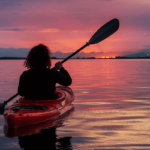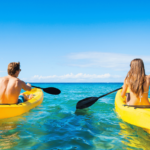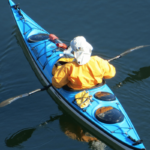Embarking on a solo canoe adventure offers a unique blend of freedom and challenge, but one crucial decision can significantly influence your experience: where to sit. This seemingly simple choice is pivotal for stability, control, and enjoyment on the water. Whether you’re a seasoned paddler or a novice embarking on your first solo voyage, understanding the dynamics of canoe positioning can transform your journey. Dive into our guide to discover the secrets of optimal seating in a solo canoe.
Finding the Balance Point
Navigating a canoe solo requires a deep understanding of how your positioning affects the vessel’s stability, speed, and maneuverability. The key to mastering solo canoeing lies in finding the canoe’s balance point. This is the spot where the canoe feels most stable and responds predictably to your paddling efforts. It’s not just about sitting in the middle; it’s about understanding the dynamics of your canoe in relation to water and how your weight distribution affects its performance.
Initially, you might be tempted to sit directly in the middle of the canoe, equidistant from both ends. However, the true balance point often shifts based on several factors, including the canoe’s design, the weight of the canoe, and the distribution of any gear you’re carrying. The goal is to position yourself so the canoe sits as flat as possible in the water, minimizing the bow or stern riding too high and catching the wind or making steering cumbersome. Experimenting with your position can help you find that sweet spot where the canoe feels almost effortless to paddle.
Adjusting your position forward or backward can dramatically alter the canoe’s handling. Moving slightly towards the stern can increase stability, especially when navigating through turbulent waters or when acceleration is needed. Conversely, shifting a bit towards the bow can improve the maneuverability of the canoe, making it easier to make sharp turns or navigate through tight spots. It’s a delicate balance that requires practice and patience to master. Remember, the optimal position is not just about where you sit, but how you distribute your weight while seated. Even slight shifts in your posture can affect the canoe’s balance.
- Start by positioning yourself slightly towards the center of the canoe, but be prepared to adjust based on the canoe’s response.
- Consider the weight distribution of any gear you have on board, aiming to keep the canoe as level as possible.
- Experiment with slight shifts forward to enhance maneuverability, especially in tighter navigational challenges.
- Shift slightly backward to increase stability, particularly useful in rougher waters or when speed is necessary.
- Pay attention to how the canoe responds to your adjustments, and continue to fine-tune your positioning to achieve optimal balance.
Finding the balance point in a solo canoe is an art that blends technical skill with a deep connection to the water beneath you. It’s about feeling the canoe’s reactions to your movements and adjusting accordingly. With practice, you’ll discover that sweet spot where the canoe seems to glide through the water with minimal effort, responding intuitively to your commands. This balance point is not a fixed location but a dynamic state that changes with conditions, requiring constant attention and adjustment. Mastering this aspect of solo canoeing will not only enhance your enjoyment of the sport but also increase your efficiency and safety on the water.
Adjusting for Optimal Control
Navigating a canoe solo is an art that requires not just strength and endurance but also a keen sense of balance and positioning. The key to mastering this art is understanding how to adjust your position in the canoe for optimal control. This doesn’t just pertain to your seating but also how you distribute weight throughout the canoe, and how you utilize your paddle. The goal is to achieve a setup that allows for efficient paddling, effective steering, and stability, especially when dealing with different water conditions.
First, consider the trim of your canoe. This is how level your canoe sits in the water, which is crucial for maintaining control. Ideally, you want your canoe to be as level as possible or slightly tilted towards the stern (back) if you’re paddling solo. You can achieve this by positioning gear or adjusting your seating towards the center of the canoe. However, avoid sitting too far back as it can make the canoe difficult to steer. If your canoe has adjustable seats, experiment with slight adjustments to find the perfect balance point. For those without this feature, strategically placing weights or gear can help achieve a similar effect.
Moreover, your paddling technique plays a significant role in maintaining control of the canoe. Efficient paddle strokes will keep the canoe moving straight and allow for easier maneuvering. It’s important to practice different strokes and understand how they affect the canoe’s movement. The J-stroke, for example, is essential for solo paddlers as it helps in steering the canoe without switching sides. Additionally, staying low in the canoe by bending your knees slightly can improve your stability, especially in choppy waters.
- Ensure the canoe is level or slightly stern-heavy.
- Adjust your seat or place weights for optimal trim.
- Practice efficient paddle strokes for better control.
- Use the J-stroke to steer without changing paddle sides.
- Stay low in the canoe to enhance stability in various water conditions.
Adjusting for optimal control in a solo canoe is not a one-size-fits-all solution. It requires a mix of understanding your canoe’s design, how weight distribution affects its behavior in water, and mastering paddling techniques that complement your physical strength and endurance. By taking the time to find your canoe’s balance point and practicing efficient paddling, you’ll not only enhance your control but also the overall enjoyment of your solo paddling adventures.
Considering Canoe Design and Size
When embarking on a solo canoe trip, understanding the intricacies of your canoe’s design and size is paramount. A canoe’s length, width, and hull shape significantly influence its stability, speed, and maneuverability. For solo paddling, the optimal position often leans towards the center of the canoe, but this can vary based on the specific design attributes of your vessel.
Canoe designs vary from wide, stable platforms ideal for fishing or photography, to sleek, narrow hulls designed for speed and efficiency in straight lines. A wider canoe offers more stability, which might allow for a more relaxed paddling position off-center. However, in a narrower canoe, maintaining a position closer to the centerline enhances balance and control. Furthermore, the size of the canoe affects how it handles when loaded. A longer canoe can distribute weight more evenly, allowing for a slightly forward or backward shift without drastically affecting stability.
The hull shape, specifically, plays a crucial role in determining your optimal seating position. A canoe with a flat-bottomed hull provides greater initial stability, making it forgiving for beginners or those looking to stay closer to shore. Conversely, a v-shaped or rounded hull can offer better secondary stability for dealing with rougher waters, but may require a more centered seating position to maintain an even keel. Understanding these factors is essential for optimizing your solo canoeing experience, ensuring safety, comfort, and enjoyment on the water.
Additional Insights on Canoe Design and Handling
Delving deeper into the relationship between canoe design and handling can provide solo paddlers with a nuanced understanding of how to optimize their positioning. The distribution of weight within the canoe, influenced by both the paddler’s position and any gear, can affect the craft’s trim. A well-trimmed canoe moves efficiently through the water, minimizing effort and maximizing speed. Experimenting with slightly forward or aft positions in different canoe models can reveal the sweet spot for each design, where the canoe feels both responsive and stable.
| Canoe Type | Optimal Solo Position | Recommended Use |
|---|---|---|
| Wide, Flat-Bottom | Slightly Rear of Center | Stability for Fishing/Photography |
| Narrow, V-Shaped Hull | Center | Speed and Long-Distance Touring |
| Medium, Rounded Hull | Center to Slightly Forward | General Recreation |
| Short, Recreational | Center | Leisure Paddling, Easy Waters |
| Long, Expedition | Center to Slightly Rear | Long-Distance Trips, Cargo Capacity |
Factoring in Wind and Water Conditions
When paddling solo in a canoe, understanding and adapting to wind and water conditions is crucial for maintaining control and efficiency. The force and direction of the wind can significantly affect your course and the amount of effort required to paddle. In calm waters, positioning yourself slightly towards the center of the canoe allows for more balanced control and easier correction of your path. However, in windy conditions, moving towards the rear, or the stern, of the canoe gives you better leverage against the wind and helps in keeping the canoe straight.
Water conditions also play a pivotal role in deciding your seating position. In fast-moving or choppy waters, sitting lower in the canoe by kneeling can lower your center of gravity, enhancing stability. It’s also beneficial to sit closer to the center in such conditions to evenly distribute your weight, making it easier to maneuver the canoe. Conversely, in calm and shallow waters, sitting towards the bow can make the canoe more agile and responsive to paddle strokes, allowing for precise movements and easier navigation through tight spaces.
Besides the immediate environmental conditions, the design and load of your canoe also influence the optimal seating position. A heavily loaded canoe will behave differently in wind and water compared to a lightly loaded one. Therefore, adjusting your position based on the cargo and canoe design is essential to maintain control and ensure a smooth journey.
| Condition | Optimal Position | Reason |
|---|---|---|
| Calm Water | Center | Balance and control |
| Windy | Stern | Leverage against wind |
| Choppy Water | Lower/Center | Stability and maneuverability |
| Calm, Shallow Water | Bow | Agility and precision |
| Heavy Load | Adjusted Center | Control and balance with load |
Factoring in wind and water conditions is not just about reacting to the elements but also about proactively adjusting your position in the canoe for optimal performance. Whether facing the relentless push of a headwind or navigating the unpredictable challenges of choppy waters, your ability to adapt your seating position can make all the difference. This skill, combined with a deep understanding of your canoe’s characteristics and the environmental conditions, will ensure a safe and enjoyable paddling experience.
Adjusting Gear for Weight Distribution
Mastering the art of solo canoeing involves not just skill in maneuvering your vessel but also in how you manage the distribution of weight within it. The key to a smooth and efficient journey lies in balancing the gear in your canoe to enhance stability and control. By strategically placing heavier items towards the center and closer to the bottom of the canoe, you can significantly lower the center of gravity. This not only minimizes the risk of capsizing but also improves the canoe’s responsiveness to your paddling efforts.
Furthermore, it’s essential to evenly distribute the weight on both sides of the canoe to prevent it from listing to one side. This might involve arranging your gear in a way that might seem counterintuitive at first but will pay off in terms of improved handling. For those embarking on longer journeys, consider using dry bags or similar containers to consolidate and organize your gear, making it easier to adjust the distribution as needed. Remember, the goal is to achieve a balance that feels right and supports your paddling style, which might require experimenting with different configurations until you find the optimal setup.
Further Insights on Gear Adjustment
Adjusting your gear for optimal weight distribution extends beyond the mere placement of items within the canoe. It encompasses understanding how the weight of your gear interacts with the water conditions you’ll be facing. For instance, in choppier waters, a slightly heavier stern can help keep the canoe tracking straight, while in calm waters, a more evenly distributed load can offer greater agility. Thus, tailoring your gear arrangement to the specific conditions of your journey can drastically enhance your overall experience.
Advanced Techniques in Weight Distribution
Exploring advanced techniques in weight distribution can unlock new levels of performance and enjoyment in solo canoeing. Consider the use of water ballasts or gear adjustments in real-time based on changing water conditions or fatigue levels. Learning to read the water and adjust accordingly can turn a challenging journey into a memorable adventure. As your skills in managing the weight distribution evolve, so too will your confidence and capability on the water.
- Identify the heaviest items in your gear and place them strategically.
- Use dry bags to consolidate small items and improve water resistance.
- Adjust the weight distribution based on water conditions.
- Practice loading and unloading to find the most balanced setup.
- Consider the use of water ballasts for additional stability.
In conclusion, the ability to adjust your gear for optimal weight distribution is a fundamental skill in solo canoeing that enhances both safety and performance. Through careful planning, practice, and adaptation to environmental conditions, you can achieve a balanced and efficient setup that complements your paddling style. Embrace the process of experimentation and learning, as it is key to mastering the art of solo canoeing.
I’m Adam Reynolds, a dedicated sports writer with a passion for both competitive gaming and betting. In my mid-thirties, I dive deep into the world of sports, providing insightful analyses and strategies to help readers make informed betting decisions. My experience spans various sporting events, where I blend my love for the game with a keen eye for betting trends. Whether I’m dissecting game tactics or offering betting tips, I aim to deliver content that is both engaging and practical. Join me as we explore the exciting intersection of sports and betting together.





